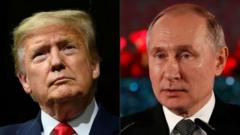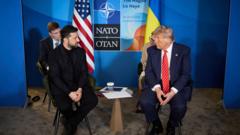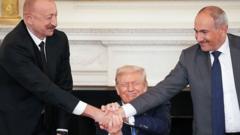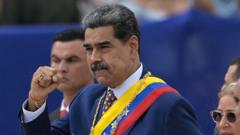As of midnight, President Trump's implementation of extensive new tariffs marks a significant shift in U.S. trade policy, impacting countries from India to Brazil. With some nations scrambling for exemptions, the global trade dynamic faces unprecedented challenges.
Trump's New Tariffs Shake Global Trade Landscape

Trump's New Tariffs Shake Global Trade Landscape
U.S. President Donald Trump's aggressive tariffs on a multitude of countries are now in effect, igniting reactions from businesses and governments worldwide.
U.S. President Donald Trump has officially rolled out sweeping new tariffs targeting a broad spectrum of countries, sending ripples through the global trade system. Just moments before the midnight deadline in Washington, DC, Trump celebrated via social media, exclaiming, "IT'S MIDNIGHT!!! BILLIONS OF DOLLARS IN TARIFFS ARE NOW FLOWING INTO THE UNITED STATES OF AMERICA!"
Among the most notable tariffs is a hefty 50% levy against India, set to take effect on August 27, which hinges on India's continued purchase of Russian oil. Additionally, Trump issued a stern warning of a looming 100% tariff on foreign-made computer chips, emphasizing his administration's desire for tech companies to bolster domestic production. Not long after this announcement, Apple unveiled plans for a remarkable $100 billion investment in the United States, a decision influenced by pressure from the White House.
Many countries have been racing against the clock to negotiate agreements with the U.S. to mitigate what Trump dubs “reciprocal tariffs.” Economies in Southeast Asia, particularly those reliant on exports like Laos and Myanmar, are among the most negatively affected. These nations are contending with stiff levies reaching as high as 40%. Analysts suggest Trump's tariff strategy appears to specifically target nations with strong trade ties to China.
While some major economies—such as the UK, Japan, and South Korea—have successfully negotiated lower tariffs, the European Union has agreed to a framework deal establishing a 15% tariff on goods exported from the bloc. Taiwan, a critical U.S. ally in Asia, faces a 20% tariff, which its president, Lai Ching-te, described as "temporary" amid ongoing discussions.
Last week, Trump also elevated the tariff on Canada from 25% to 35%, citing insufficient cooperation in stemming drug trafficking across the U.S. border. However, the majority of Canadian exports will remain unaffected by this tariff due to the existing United States-Mexico-Canada Agreement (USMCA). Meanwhile, tariffs on Mexico's imports have been postponed for an additional 90 days as negotiations continue.
In a related development, Trump signaled a 100% tariff on foreign-made semiconductors, although major chip manufacturers with substantial investments in the U.S. may avoid these new charges. Taiwan's TSMC, as well as South Korea's SK Hynix and Samsung, are reportedly exempt from the levy, although official statements from the White House remain pending.
On Wednesday, Trump further escalated tensions by imposing a 50% tariff on Brazilian exports after accusing President Luiz Inacio Lula da Silva of unfairly targeting U.S. technology firms. The rising tensions have sparked various global reactions, with many businesses expressing shock and relief as they navigate the implications of the new tariffs.
The ongoing negotiations between the U.S. and China are also critical, as both nations attempt to extend a 90-day tariffs pause that is set to expire on August 12, signaling the potential for further shifts in global trade relations.



















